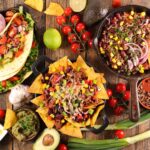Latin American gastronomy is a vibrant mosaic of flavors, textures, and traditions, deeply rooted in the region’s unique biodiversity. Beyond basic ingredients and ancestral recipes, the diversity of flora and fauna that characterizes Latin America has been an essential driver in the creation and evolution of its regional cuisines, providing richness, innovation, and a sense of cultural identity that transcends generations.
Biodiversity as a Source of Culinary Identity
Each country and region in Latin America has its own ecosystem, providing unique ingredients and culinary techniques adapted to its environment. From tropical rainforests to the Andean mountain ranges, the variety of plant and animal species has shaped the way food is prepared and recipes are passed down. For example, in Mexico, ingredients such as chili, corn, squash, and chia have become cultural symbols, while in Peru, quinoa, potatoes, and a wide variety of seafood reflect the richness of its marine and terrestrial biodiversity.
Impact on Innovation and Diversity of Flavors
The abundance of local species allows traditional and modern cooks to experiment with new flavors and techniques, enriching traditional recipes and creating unique fusions. Hunting endemic species, using medicinal plants, and incorporating rare ingredients foster a dynamic and constantly evolving gastronomy. For example, in the Amazon, the use of fruits such as cupuaçu, guayusa, and medicinal plants in dishes and beverages has opened up new sensory experiences.
Conservation and Sustainability Through Gastronomy
Recognizing the value of biodiversity in gastronomy also drives conservation and sustainability efforts. By valuing and promoting native ingredients, local communities strengthen their economies and preserve their natural heritage. In countries like Ecuador and Bolivia, sustainable fishing and agriculture practices are being promoted that guarantee the protection of endangered species and the conservation of vital ecosystems, ensuring that future generations can continue to enjoy these unique ingredients.
The Role of Biodiversity in Cultural Identity and Gastronomic Tourism
Biodiversity not only enriches flavors but also strengthens cultural identity and tourism in the region. Travelers seek authentic and sustainable experiences, interested in dishes that reflect the natural diversity of each area. Gastronomy based on native ingredients and traditional techniques has become a tourist attraction, raising awareness about the importance of preserving these ecosystems and their resources.
Biodiversity in Latin America is much more than a natural heritage; it is the very root of its cuisine. The variety of local flora and fauna not only enriches flavors and culinary techniques but also drives innovation, sustainability, and cultural identity. At Azúcar Restaurant, we celebrate this natural wealth, using native ingredients that reflect the diversity of our region, creating dishes that are true journeys of flavor and tradition. Because in every bite, we honor the magic and biodiversity that make Latin American cuisine unique.
To learn more about our offerings and explore our authentic flavors, visit azucarrestaurantmd.com












